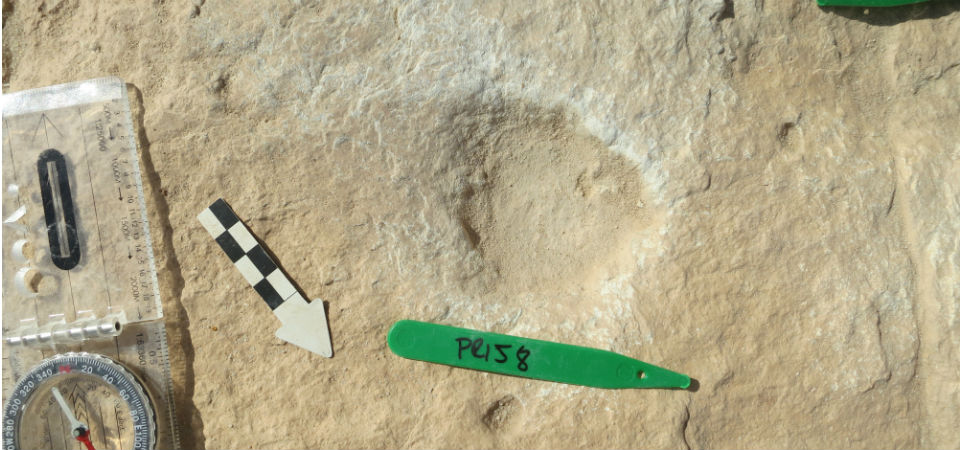Fossilised footprints (shown above) found in the Nefud Desert – a 25,000 sq mile (100,000 km2) region of the larger Arabian Desert, in Saudi Arabia – show how a group of two or three people stopped at an ancient lake to drink and forage.
Dotted around alongside the human prints – the oldest evidence for Homo sapiens in Arabia – archaeologists also found tracks belonging to elephants, camels, buffalos and horses.
In a new paper, published in partnership with the Saudi Ministry of Culture, the team – made up of experts from 13 institutions – provided a unique snapshot of life in prehistoric Saudi Arabia.
The evidence supports what is already known about prehistoric migration of H. sapiens out of Africa with the earliest evidence between about 210,000 and 180,000 years ago from southern Greece and the Levant respectively – a period when scientists believe early humans left the savannas of eastern Africa and roamed northwards for the first time.
 The location of the Nefud desert and Alathar where the footprints were found
The location of the Nefud desert and Alathar where the footprints were found
Dr Dave Ryves, of Loughborough University, analysed diatoms – microscopic, single-celled algae – found at the Alathar footprint site to confirm the presence of freshwater.
He said: “Analysing samples from the sequence of diatoms showed us that the sites were indeed shallow freshwater lakes – probably changing in level, but always staying freshwater.
“The implication is that there was always an abundant source of fresh water in the landscape at that time.
“This would have been crucial for allowing these early humans to move into and across the area along a ‘freshwater corridor’ in what was then a very different, green Arabia.”
 The team at Alathar - Credit: Palaeodeserts Project
The team at Alathar - Credit: Palaeodeserts Project
The animal tracks were discovered in 2017, by Professor Nick Drake from King’s College London who was surveying the ancient lake deposit for fossils and lithic (stone) artefacts.
He noticed that some of the larger impressions resembled elephant footprints.
Later that day, the human tracks were identified by Klint Janulis, an archaeology PhD student from the University of Oxford.
It is believed that the prehistoric travellers stopped at the lake for only a short time.
These particular tracks were fossilised as the lake was in the late stages of drying up and the hot sun had hardened the muddy footprints before they were destroyed.
Lead author Dr Mathew Stewart, from the Max Planck Institute for Chemical Ecology, in Germany, said: “There are a few reasons we suspect humans may have briefly visited the lake for foraging and collecting water resources.
“Firstly, sedimentological evidence suggests that the lake was drying up around the time that humans and animals visited it, although this was not the death of the lake as there are overlying lake sediments preserved in certain areas at the site.
“So perhaps just seasonal drying.
“Secondly, there is a dense concentration of footprints at the site.
“This occurs often in areas where lakes and rivers dry up seasonally, such as in the savannas of eastern Africa, forcing large herds of animals to congregate around diminishing water resources.
“And lastly, there are no stone tools or evidence for carcass exploitations – from the fossil remains – suggesting that people were only briefly there.”

Thermal imaging of one of the footprints found at Nefud
The paper suggests that the area in which the lake was situated was part of a popular route that early humans took out of Africa between about 120,000 and 80,000 years ago.
The dispersal north coincides with the well-known Skhul (or Qafzeh) fossils – Homo sapiens remains found in Israel in the 1920s, which demonstrate the earliest journey north by humans.
Dr Stewart said: “The Skhul hominin fossils in Israel are typically considered to represent a sapiens dispersal out of Africa, and these fossils are contemporary with the Alathar footprints.
“So, our findings suggest that dispersals of sapiens out of Africa in the last interglacial, a warmer, wetter period between Ice Ages, included part of northern Arabia.
“Indeed, the data from Alathar, as well as other sites, tell us that the region may have been particularly attractive to dispersing hominins—for example, a setting characterised by expansive grasslands with large, permanent freshwater lakes that supported a variety of mammals, including large species like elephant and hippo.”
 An equid footprint - Credit: Gilbert Price
An equid footprint - Credit: Gilbert Price
The researchers on this project were based at:
• Max Planck Institute (Jena) - Germany
• Royal Holloway University of London - UK
• King’s College London - UK
• University of Oxford - UK
• University of Bergen - Norway
• Loughborough University - UK
• Griffith University - Australia
• University of Queensland - Australia
• University of Tübingen - Germany
• Fundación Instituto de Investigación de Prehistoria y Evolución Humama - Spain
• Saud University - Saudi Arabia
• Saudi Commission for Tourism and National Heritage - Saudi Arabia
• Smithsonian Institution – USA
ENDS
